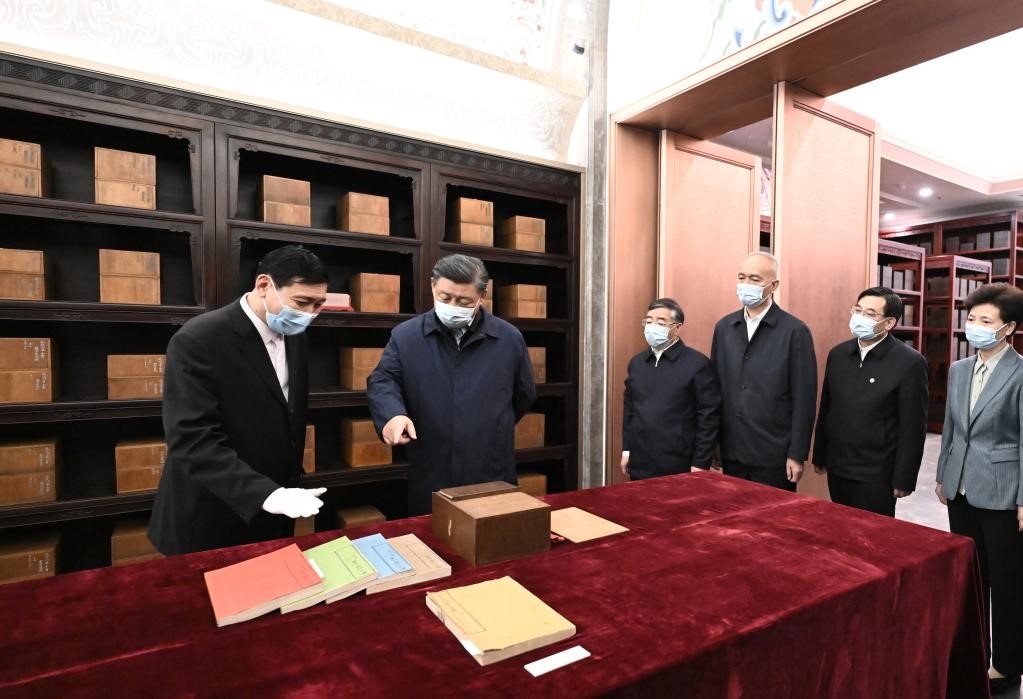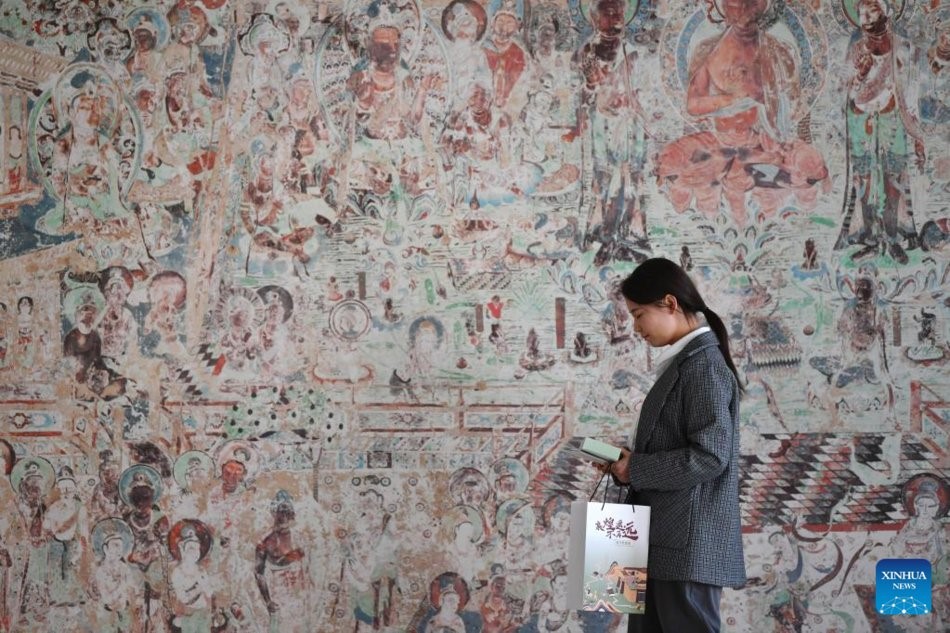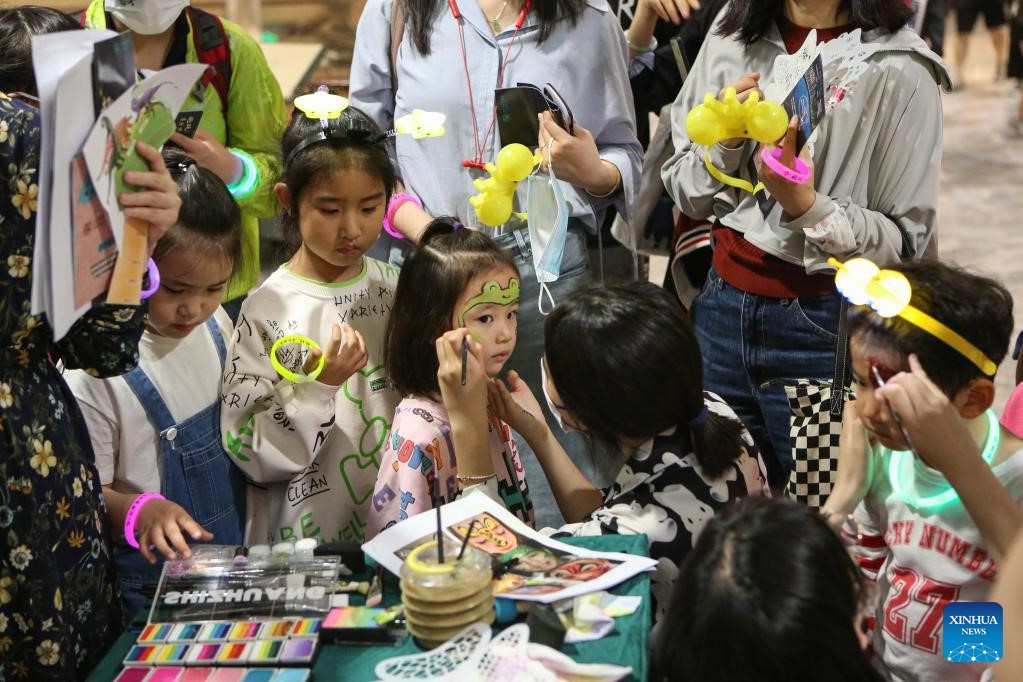The unfailing admiration that the splendor of China’s traditional culture inspires in people throughout the world is often accompanied by their amazement at the modern innovations mirroring China’s ancient civilization. This was apparent at the recently concluded five-day China (Shenzhen) International Cultural Industries Fair (ICIF) in June. In addition to digitally showcasing the ingenious inventions, cultural relics, and intangible cultural heritage of ancient China, the digital China exhibition area also highlighted the cultural industry’s latest technological creations at the fair.
China’s cultural missions in the new era are to further advance cultural prosperity, to build a leading country in culture, and to foster the modern Chinese civilization, Chinese President Xi Jinping said on June 2 in his address to a meeting on cultural inheritance and development.

Chinese President Xi Jinping visits an exhibition hall of the China National Archives of Publications and Culture, and learns about the preservation of classic publications in its collection in Beijing on June 1, 2023. (Xinhua/Yan Yan)
In recent years, facing up to a string of daunting challenges, China has, under the leadership of the Communist Party of China (CPC), secured successive victories on many fronts. Particularly noteworthy is the social stability and palpability of the people’s happiness amid the country’s rapid economic development and dramatic social changes. “Our experience has taught us that, at the fundamental level, we owe the success of our Party and socialism with Chinese characteristics to the fact that Marxism works, particularly when it is adapted to the Chinese context and the needs of our times,” Xi Jinping stated in the report delivered to the 20th CPC National Congress. The report moreover held that, in order to ensure Marxism retains its vigor and vitality, Chinese Communists must integrate the basic tenets of Marxism with China’s specific realities and fine traditional culture. Only by taking root in the nation’s rich historical and cultural soil can the truth of Marxism flourish here, the report pointed out.
Protection and Inheritance of China’s Ancient Civilization
Stemming from a history that reaches back to antiquity, China’s fine traditional culture is extensive and profound. It is crystallized in the expression of ancient wisdom through such maxims as pursuing the common good, regarding the people as the foundation of the state, governing by virtue, embracing the world with virtue, and promoting harmony between humanity and nature. The country’s ancient civilization is the cultural fountainhead of China’s many governance concepts and international proposals – such as the people-centered governance philosophy, the idea that lucid waters and lush mountains are invaluable assets, the building of a community with a shared future, as well as global development, security and civilization initiatives.
A comprehensive and profound understanding of the long and continuous Chinese history is essential to promoting the creative transformation and development of fine traditional Chinese culture more effectively, and to developing modern Chinese civilization, Xi said at the recent cultural inheritance and development meeting. He went on to summarize the five prominent features of Chinese civilization: consistency, originality, unity, inclusivity, and its pursuit of peace.
The country has thus attached great importance to the protection of cultural heritage. President Xi has indeed set aside time during his many domestic inspection tours to learn about the protection of cultural relics.

Liao Xueting, a marketer from the Dunhuang Academy's digital preservation team, walks past a high-fidelity replica of a mural in Dunhuang, northwest China's Gansu Province, on April 25, 2023. A group of young technicians have sought to use digital technology to ensure the permanent preservation and sustainable use of cultural relics in the Mogao Grottoes, a UNESCO World Heritage site in Dunhuang. [Xinhua/Chen Bin]
President Xi visited Dunhuang during his inspection tour of northwest China's Gansu Province in August 2019, and presided over a symposium at the Dunhuang Academy. “The protection of world cultural heritage should be placed above tourism as the top priority. We should not set our eyes merely on selling tickets and pursuing economic benefits,” he said. The Mogao Grottoes in Dunhuang, a renowned UNESCO World Heritage Site, house rich collections of Buddhist artworks – more than 2,000 painted sculptures and 45,000 square meters of murals – in 735 caves along a cliff. Xi hailed Dunhuang culture as “a bright pearl in the long river of world civilization, and precious historical material for the study of the politics, economy, military, culture, and art of various ethnic groups in ancient China.” Dunhuang Academy utilized new technology in its endeavor to protect the grottoes and so preserve that world heritage. As of the end of 2022, Dunhuang Academy had compiled digital data on 278 caves. It included image processing for 164 of them and 3D reconstruction of 145 painted sculptures and seven ruins, in addition to delivering a panoramic tour program for 162 caves, according to Xinhua News Agency
China is now home to 56 UNESCO world heritage sites; 38 of them are cultural, 14 are natural heritage sites, and four are cultural and natural (mixed) sites, an amount that clinches the country a global second position. Meanwhile, the UNESCO Intangible Cultural Heritage list includes 43 items from China, which is more than that from any other country.
The importance China has attached to preserving cultural heritage over the past decade is evident in its being included in the performance assessment system of 27 provincial governments. The number of provincial-level cultural relics protection units has risen 58 percent, and that of municipal and county-level units by 88 percent. During the past 10 years the central government budget has allocated a total of RMB 100 billion to cultural heritage.
On June 1 and 2, President Xi visited the China National Archives of Publications and Culture (CNAPC) and the Chinese Academy of History in Beijing. Established in July 2022, the CNAPC is dedicated to the collection and preservation of Chinese publications from different eras and other relevant data. It is now home to more than 25 million documents in various forms, from ancient classics, to important publications and digital files.
“In an era of national prosperity and social stability, we have the will and capacity to carry forward Chinese culture, and we should accomplish this great undertaking well,” Xi said during his CNAPC visit.
The Chinese Academy of History, established in January 2019, is a subsidiary of the Chinese Academy of Social Sciences. Its main duties include organizing and guiding the country’s historical research and implementing major national academic projects on the study of history. As Xi observed, a clear understanding of history is key to China's cultural development in the new era.
New Expressions of an Ancient Civilization
Preserving cultural heritage and gaining a good understanding of Chinese history will promote the creative transformation and innovative development of fine traditional Chinese culture. Xi said, “With unwavering cultural confidence, a profound sense of mission, and a spirit of relentless endeavor, we must unite our efforts to create a new culture for our times.”
Beijing’s cultural innovation proceeds in tandem with relevant institutional innovation. As the nation’s cultural center, the ancient capital is witnessing culture’s integration with finance, technology, and tourism, thus vitalizing local cultural development. Distinctive cultural industrial parks, including Beijing Fun, the 798 Art Zone, and the 77 Cultural and Creative Park, are fast becoming new urban cultural landmarks of cultural creation and consumption. Statistics show that, in 2022, cultural enterprises above the designated size in Beijing generated a total income of RMB 1.8 trillion, so topping the national comprehensive development index for cultural industries.

Children experience face painting at Shanghai Natural History Museum in Shanghai, east China, May 18, 2023. Shanghai Natural History Museum(SNHM) held a special event themed "Night at the SNHM" in celebration of the International Museum Day. (Xinhua/Xin Mengchen)
In Shanghai, meanwhile, efforts to preserve the distinct cultural ethos of the city’s 3,075 excellent historical buildings, 397 culturally characteristic streets, and 44 areas with unique historical and cultural features, go hand-in-hand with its endeavor to build new cultural parks; for example, by transforming a brewery into an environmental protection-themed park. Shanghai has also taken the lead nationally in building a modern service system for public culture through the city’s public cultural groupings that are within a 10-minute-walk radius of residents in urban downtown areas and a 15-minute-walk-radius of those in suburban areas, which have now basically taken shape. Cultural venues and institutions have thus organically formed clusters. In 2022, the cultural and creative industry accounted for 13 percent of Shanghai’s GDP, so displaying a vibrant development momentum.
Shenzhen, a city whose rise to the status of national technical innovation center is attributable to the country’s reform and opening-up drive, continues to forge ahead on the strength of the its native spirit. In 2015, the local government released a plan for the city’s development of cultural and creative industries, thus highlighting its goal to foster a prosperous culture while advancing economic and innovative development. Hence, innovation, rule of law, pragmatism, and civilization have become synonymous with the Shenzhen spirit. Public cultural services in Shenzhen are also benefitting from a range of nascent cultural projects that include building “a book town for each district and a book bar for each street” and renovating “10 distinctive cultural blocks.” Shenzhen is also among the top 10 Chinese cities for digital reading. More than that, the China (Shenzhen) International Cultural Industries Fair (ICIF) has become the SEZ’s cultural hallmark. The volume of trade deals at the freshly concluded 19th ICIF reached RMB 3.42 billion – a record high. Resplendent in the display of more than 120,000 cultural products, the 19th ICIF set up 64 parallel sessions branching out from the major venue which welcomed around 4 million visitors and participants.
Cultivating the Garden of World Civilizations
On March 15, 2023, at the CPC in Dialogue with World Political Parties High-level Meeting in Beijing, President Xi Jinping proposed the Global Civilization Initiative, which advocates respect for the diversity of civilizations and the common values of humanity, and emphasizes the importance of inheritance and innovation of civilizations, and robust international people-to-people exchanges and cooperation. As the future of all countries are closely connected, tolerance, coexistence, exchanges and mutual learning among different civilizations play an irreplaceable role in advancing humanity's modernization process and making the garden of world civilizations flourish, Xi observed.
Since the relaxation of China’s COVID-19 policy in late 2022, China has embraced waves of cultural and people-to-people exchanges with foreign countries. The long pent-up demands for in-person communications and cultural exchanges have hence finally found channels. On January 17, 2023, the “Botticelli to Van Gogh: Masterpieces from the National Gallery” exhibition at the Shanghai Museum – the U.K. National Gallery’s first-ever exhibition in China – opened, and ran for more than four months. From February 24 to April 15, the Inside-Out Art Museum in Beijing hosted the “Italian Contemporary Art and Artists on the Silk Road” exhibition, curated by art historian and critic Angela Tecce, which presented the artworks of more than 30 Italian artists spanning half a century or more. A leading project of the China-Italy Year of Culture and Tourism, the exhibition offered a comprehensive vista of Italian contemporary art. Another European country with an ancient civilization also found a Chinese audience for its culture this year. The Greek Mythology Digital Art Carnival, held in Beijing from April 1 to June 30, combining digital art and mixed reality technology, took the audience to the world of ancient Greece. “The love and respect Chinese people have for Greece and Greek mythology never fails to amaze me, but this metaverse presentation has really hit the ball out of the park," head of the public diplomacy office of the Greek Embassy in China Nestor Tyrovouzis said at the opening ceremony of the carnival, according to the Global Times.

The exhibition, titled "The Legend of China's Qin and Han Dynasties," held in Spain is part of a series of activities for the China-Spain Year of Culture and Tourism. [Photo/Xinhua]
Meanwhile, Chinese ancient artworks have also wowed foreign aficionados overseas. An exhibition of China’s renowned Terracotta Warriors opened on March 28 at the Archaeological Museum of Alicante in Spain, and will run through to January 28, 2024. The exhibition, titled “The Legend of China's Qin and Han Dynasties,” showcases more than 120 exhibits from nine Chinese museums, including 10 life-size Terracotta Warriors and horses. Carlos Mazon, president of Alicante provincial council, acclaimed the exhibition “a historic moment,” saying that he believed his province “will become a cultural center in Europe in the next ten months, because it is the first time that the Chinese Terracotta Warriors have been exhibited abroad since the (COVID-19) pandemic," according to Xinhua.
In Brussels, meanwhile, the “Longquan City Celadon Art” exhibition was held from April 3 to 28 at the Chinese Cultural Center of the Belgian capital. The 55 works on exhibit by Chinese artists highlighted the exquisite porcelain craftsmanship, listed in 2009 as a UNESCO intangible cultural heritage of humanity.
At the recent meeting on cultural development and inheritance, President Xi emphasized the importance of exchanges and mutual learning among civilizations to enrichment of the global garden of civilizations. “We are ready to work together with the international community to open up a new prospect of enhanced exchanges and understanding among different peoples and better interactions and integration of diversified cultures. Together we can make the garden of world civilizations colorful and vibrant,” Xi concluded at the CPC in Dialogue with World Political Parties High-Level Meeting in March.